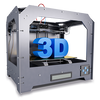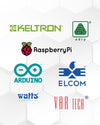
Soil and Crop Sensing
INTRODUCTION

Sensors that measure a variety of essential soil properties on the go are being developed. These sensors can be used either to control variable rate application equipment in real-time or in conjunction with a Global Positioning System (GPS) to generate field maps of particular soil properties. Depending on the spacing between passes, travel speed, and sampling and/or measurement frequency, the number of measurement points per acre varies; however, in most cases, it is much greater than the density of manual grid sampling. The cost of mapping usually is reduced as well.
Measuring Soil Properties
When thinking about an ideal precision agriculture system, producers visualize a sensor located in direct contact with, or close to, the ground and connected to a “black box” which analyzes sensor response, processes the data, and changes the application rate instantaneously. They also hope that the real-time information detected by the sensor and used to prescribe the application rate would optimize the overall economic or agronomic effect of the production input. This approach, however, does not take into account several difficulties met in the “real world”:
- Most sensors and applicator controllers need a certain time for measurement, integration, and/or adjustment, which decreases the allowable operation speed or measurement density.
- Variable rate fertilizer and pesticide applicators may need additional information (like yield potential) to develop prescription algorithms (sets of equations).
- Currently, there is no site-specific management prescription algorithm proven to be the most favorable for all variables involved in crop production.
Rather than using real-time, on-the-go sensors with controllers, a map-based approach may be more desirable because of the ability to collect and analyze data, make the prescription, and conduct the variable rate application in two or more steps. In this case, multiple layers of information including yield maps, a digital elevation model (DEM), and various types of imagery could be pooled together using a geographic information system (GIS) software package designed to manage and process spatial data. Prescription maps can be developed using algorithms that involve several data sources as well as personal experience.
Sensors for Automated Measurements
Scientists and equipment manufacturers are trying to modify existing laboratory methods or develop indirect measurement techniques that could allow on-the-go soil mapping. To date, only a few types of sensors have been investigated, including:
- Electromagnetic
- Optical
- Mechanical
- Electrochemical
- Airflow
- Acoustic
Electromagnetic sensors use electric circuits to measure the capability for soil particles to conduct or accumulate electrical charge. When using these sensors, the soil becomes part of an electromagnetic circuit, and changing local conditions immediately affect the signal recorded by a data logger. Several such sensors are commercially available:
- Mapping electrical conductivity (Veris® 3100, Veris Technologies, Salina, Kansas)
- Mapping transient electromagnetic response (EM-38,Geonics Limited, Mississauga, Ontario, Canada)
- Using electrical response to adjust variable rate application in real-time (Soil Doctor® System, Crop Technology, Inc., Bandera, Texas)
Electromagnetic soil properties, for the most part, are influenced by soil texture, salinity, organic matter, and moisture content. In some cases, other soil properties such as residual nitrates or soil pH can be predicted using these sensors. Several approaches for applying electromagnetic sensors have been observed in recent years.
Optical sensors use light reflectance to characterize soil. These sensors can simulate the human eye when looking at soil as well as measure near-infrared, mid-infrared, or polarized light reflectance. Vehicle-based optical sensors use the same principle technique as remote sensing. To date, various commercial vendors provide remote sensing services that allow measurement of bare soil reflectance using a satellite or airplane platform. Cost, timing, clouds, and heavy plant residue cover are major issues limiting the use of bare soil imagery from these platforms.
Close-range, subsurface, vehicle-based optical sensors have the potential to be used on the go, in a way similar to electromagnetic sensors, and can provide more information about single data points since reflectance can be easily measured in more than one portion of the spectrum at a time. Several researchers have developed optical sensors to predict clay, organic matter, and moisture content.
Mechanical sensors can be used to estimate soil mechanical resistance (often related to compaction).These sensors use a mechanism that penetrates or cuts through the soil and records the force measured by strain gauges or load cells. Several researchers have developed prototypes that show the feasibility of continuous mapping of soil resistance; however, none of these devices is commercially available. The draft sensors or “traction control” system on tractors uses a similar technology to control the three-point hitch on the go.
Electrochemical sensors could provide the most important type of information needed for precision agriculture — soil nutrient levels and pH. When soil samples are sent to a soil-testing laboratory, a set of standardized laboratory procedures is performed. These procedures involve sample preparation and measurement. Some measurements (especially determination of pH) are performed using an ion-selective electrode (with glass or polymer membrane or ion sensitive field effect transistor). These electrodes detect the activity of specific ions (nitrate, potassium, or hydrogen in case of pH). Several researchers are trying to adapt existing soil preparation and measurement procedures to essentially conduct a laboratory test on the go. The values obtained may not be as accurate as a laboratory test, but the high sampling density may increase the overall accuracy of the resulting soil nutrient or pH maps.
Airflow sensors were used to measure soil air permeability on the go. The pressure required to squeeze a given volume of air into the soil at fixed depth was compared to several soil properties. Experiments showed potential for distinguishing between various soil types, moisture levels, and soil structure/compaction.
Acoustic sensors have been investigated to determine soil texture by measuring the change in noise level due to the interaction of a tool with soil particles. A low signal-to-noise ratio did not allow this technology to develop.
Sensor Data Usage
Although various vehicle-based soil sensors are under development, only electromagnetic sensors are commercially available and widely used. Ideally, producers would like to operate sensors that provide inputs for existing prescription algorithms. Instead, commercially available sensors provide measurements such as electrical conductivity (EC) that cannot be used directly since the absolute value depends on a number of physical and chemical soil properties such as: texture, organic matter, salinity, moisture content, etc. Alternatively, electromagnetic sensors give valuable information about soil differences and similarities, which makes it possible to divide the field into smaller and relatively consistent areas referred to as management zones.
For example, such zones could be defined according to various soil types in a field. In fact, electrical conductivity maps usually can better reveal boundaries of certain soil types than soil survey maps (used for rural property tax assessment). Different anomalies such as eroded hillsides or ponding also can be easily identified on an electrical conductivity map. The following figure compares a soil survey and an electrical conductivity map for the same field showing some differences in boundaries.

Yield maps also frequently correlate to electrical conductivity maps, as shown below. In many instances, such similarities can be explained through differences in soil. In general, the electrical conductivity maps may indicate areas where further exploration is needed to explain yield differences. Both yield potential and nutrient availability maps may have a similar pattern as soil texture and/or organic matter content maps. Often these patterns also can be revealed through an electrical conductivity map.
Therefore, it seems reasonable to use on-the-go mapping of electromagnetic soil properties as one layer of data to discover the heterogeneity (differences) of soil within a field (similar to using bare soil imagery). Zones with similar electrical conductivity and a relatively stable yield may receive a uniform treatment that can be prescribed based on fewer soil samples in the zones on the electrical conductivity map.
As new on-the-go soil sensors are developed, different real-time and map-based variable rate soil treatments may be economically applied to much smaller field areas, reducing the effect of soil variability within each management zone.
Summary
More accurate soil property maps are needed to successfully implement site-specific management decisions. Inadequate sampling density and the high cost of conventional soil sampling and analysis have been limiting factors. On-the-go, vehicle-based soil sensors represent an alternative that could both improve the quality and reduce the cost of soil maps. When further developed, on-the-go soil sensors may be used for either real-time or map-based control of agricultural inputs. To date, only systems that map electromagnetic soil properties are available commercially. These maps can be used to define management zones reflecting obvious trends in soil properties. Each zone can be sampled and treated independently. Smaller management zones will be feasible when new on-the-go soil sensors are developed and commercialized.
Researchers at the University of Nebraska continue work on vehicle-based soil sensors, which could be used for research and commercial applications. The sensors can improve the quality and decrease the cost of soil maps and will facilitate the decision-making process.



